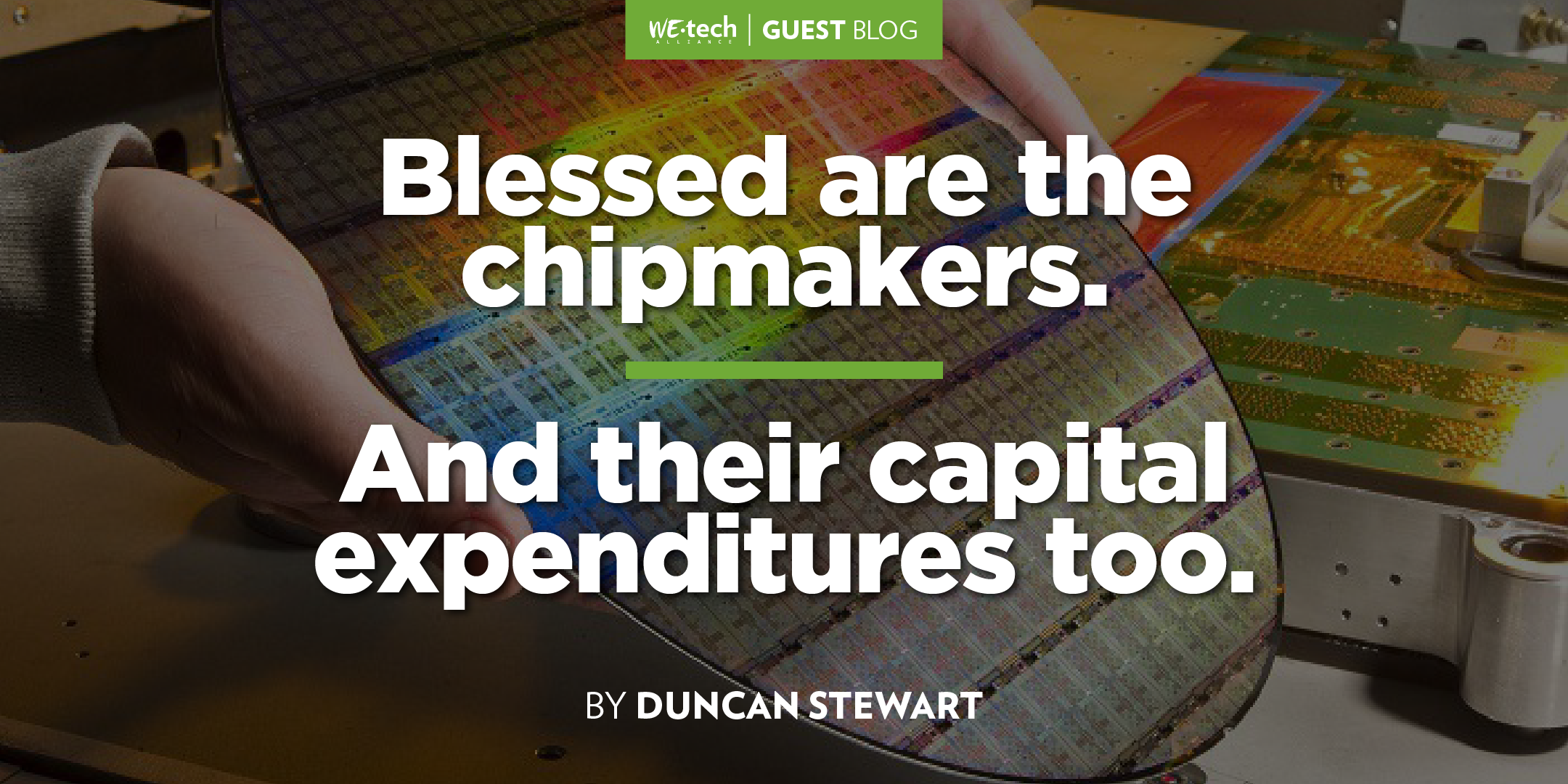‘Blessed are the chipmakers. And their capital expenditures too.’ is part of a series of articles written by Duncan Stewart, and republished here with his permission. These articles are Duncan’s personal opinion and analysis, and not official Deloitte research. These article were originally posted in the last 12 months, but have not been updated. Although Duncan used to be in the investment business, these articles are not intended to provide investment advice, but merely provide information on broader trends in tech, media and telecom (TMT.) Duncan has more than three decades of experience in TMT. He has been a research analyst, investor, venture capitalist, public speaker and columnist for both radio and newspapers.
The most important tech story today is about the companies that make chips and how much they plan on spending on capital expenditures (capex). Companies like Apple are designing cutting edge semiconductors…but someone else still has to manufacture them. The three companies best at making the best chips today are TSMC, Samsung and Intel.
Demand is much higher than supply right now, and TSMC just said that their 2021 capex will be up to $28 billion. That number is up 63% from $17.2B last year and is over 50% of what analysts predict TSMC’s revenues to be. In other recent chipmaker news, Intel just announced that Pat Gelsinger (CEO at VMware, and before that Intel’s first CTO) will be the new CEO as of February 15. They also pre-announced that they exceeded guidance for Q4 and will have their regularly scheduled earnings call on Thursday January 21.
All chips are equal…but some are more equal than others
The global chip industry had revenues of $433 billion in 2020, up 5% from 2019, and is expected to grow over 8% in 2021 to $470 billion. The industry is historically cyclical and volatile, with growth sometimes being up 50% or down 40%, see chart below. Given that context, 8% growth for next year seems good but not the distressing “boom and bust” sometimes seen.

All else being equal, having smaller transistors and thinner layers is better: chips have more transistors, are smaller, use less power, and are cheaper (or some mix of those.) This is called process node, and back in 1971 was at 10 microns, compared to a human hair at around 50 microns. By 1984, features became smaller than one micron, and since then process nodes have been measured in nanometers (nm).
In late 2018, Samsung started making chips for customers at the 5 nm process node, and TSMC joined them in 2019. And Intel????
(In these types of posts, I try to not be negative about an individual company. Intel has been a leader at not just designing chips but also manufacturing them for almost 50 years now. One cannot have a conversation about leading edge silicon manufacturing without talking about Intel. It just isn’t possible.)
Intel has been having difficulties shrinking nodes for a while now. It had multiple problems at 10 nm. It does not have 7 nm technology today, and they recently announced it won’t be available until late 2022 or early 2023. (By that point, TSMC and Samsung may have working 3 nm node chips on the market.) Five nanometer is on the roadmap…but at an unspecified time.
Leading edge 7 nm and 5 nm chips are not the biggest part of the nearly half trillion dollars of global chip revenues yet: as an example, only 8% of TSMCs revenues are coming from 5 nm as of October 2020. But they will become an increasingly large part over time, and leading edge process nodes (once the bugs are worked out) tend to be the most profitable.
How much capex is enough?
Total semiconductor capital expenditures for 2020 were $108 billion, or 25% of the $433B in revenues.
For a decade long period (see chart below) annual capex spending from Intel and TSMC was fairly similar. TSMC’s announced 2021 capex of $28B is 133% greater than the $12B people are predicting for Intel. (Samsung has a lot of memory spending, so their pattern should be and tends to be less in sync with the other two.)

Not only is that a big gap between TSMC and Intel, but the 2021 capex represents 52% of TSMC’s projected 2021 revenues, which is very high historically…both for TSMC itself and even for any company in the space.
1. Can TSMC afford to spend that much? The usual way of looking at capex is as a percentage of revenues. But I think we may be entering a new era, where capex is based off market cap instead. As can be seen in the table below, when we look at capex/revenues, there is a big spread between the big three. But when it is capex/market cap, they are all around the 4-5% level. Market cap is an interesting thing, in that it reflects the Street’s views not just on current revenues, but all future revenues, earnings and cash flows. (In finance theory, share price is the discounted value of all future cash flows or earnings.) Based on that, TSMC’s spending looks pretty reasonable.

2. Could there be another reason why TSMC capex is so high? Yup. I am seeing a lot of discussion that Intel may announce that it is giving up on making their own 7 nm chips. They will still design them, but the actual manufacturing may be done by someone else…likely TSMC. That would neatly cover why the 2021 Intel and TSMC capex levels are where they are: Intel won’t need to spend on 7 nm, and TSMC would need to expand capacity to handle extra chips from Intel. There are currently severe chip shortages across many parts of the semi industry today, with particularly severe effects on the auto industry (the average car has 50-150 chips).

Duncan Stewart is an engaging, energetic speaker and visionary, providing companies with the insight they need to plan for the future. Duncan has co-authored one of Deloitte’s premier publications, TMT Predictions, since 2008 in addition to other research. With more than two decades of experience in the TMT industry, Duncan provides insight about what’s going to happen next – a key strategic driver for companies in all industries. As an analyst and portfolio manager, Duncan has provided research or made investments in the Canadian technology and telecommunications sector, winning the Canadian Technology Fund Manager of the Year award in its inaugural year.
You can watch a replay of Duncan’s most recent (virtual) stop in Windsor-Essex & Chatham-Kent for his 2021 TMT Predictions presentation HERE.






























































